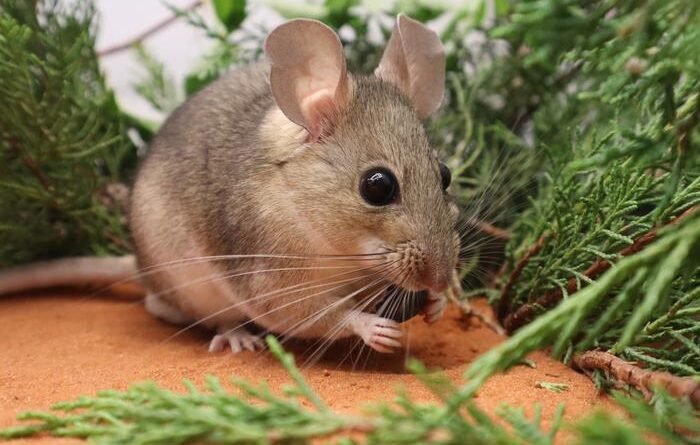Woodrats and Poisonous Plants – What Their Diets Reveal?
Woodrats and their diet have captured the attention of scientists in the United States, who conducted an almost eight-year study of their feeding habits across North America. Researchers were particularly interested in how these animals survive despite consuming plants rich in toxic compounds.
Unlike predators, herbivores eat plants that are rich in toxins but low in energy. That’s why they have to combine different plants to get enough nutrients without overburdening their bodies with toxins. Each plant contains different nutrients and toxic compounds, so most herbivores eat a variety of foods to maintain a balanced diet and avoid straining their detoxification systems.
The study, published in September 2025 in Proceedings of the National Academy of Sciences, showed that while woodrats behave as generalists at the population level, individual animals consistently select a relatively narrow subset of plants. This strategy allows them to minimize the risks of consuming toxic plants while maintaining sufficient dietary variety for survival.
The study involved numerous scientists, Sara B. Weinstein, Dylan M. Klure, Efthymia Symeonidi, Robert Greenhalgh, Margaret L. Doolin, M. Denise Dearing, Marc T. Mayes, Tess E. Stapleton, Andrea Swei, and Michael V. Cove.
Dr. Sara Weinstein, the corresponding author of the study from the Utah State University Department of Biology, answered questions about the potential significance of woodrat saliva for the development of antitoxins. She also commented on how climate change might affect woodrats’ diets and survival.
The study
“Accurately characterizing dietary specialization is critical for understanding species’ resilience; however, this component of niche breadth remains poorly understood in mammalian herbivores,” the study notes. To address this knowledge gap, researchers examined 569 individuals representing 13 species from 57 populations. Woodrats (Neotoma spp.) are remarkable for their ability to eat plants that would be lethal to most other herbivores—such as creosote bush, mesquite, or juniper, all rich in alkaloids and terpenes.
Thanks to their abundance, wide distribution, and the traces they leave behind via DNA-analyzable droppings, woodrats are an ideal model for studying feeding decisions in the wild. They studied this on a large geographic scale, spanning different populations and habitats. They then wanted to see if what they were seeing across multiple populations held for a single population. To do this, they used a single population that had been monitored for five years. They only analyzed animals that had been captured at least three times, so they could track their feeding habits over time and see how individual diets changed within the population.
The results showed that although most populations are generalists, individual animals select a relatively narrow and consistent subset of plants to obtain sufficient nutrition while avoiding poisoning. These findings highlight that dietary strategies have important implications for species resilience, population stability, and understanding food webs in changing environments.
Can woodrats’ gut microbes fight toxins in a changing climate?
Since they eat very toxic plants, I wonder whether a more detailed study—such as analyzing saliva samples—could contribute to the development of antibiotics or antitoxins?
Dr. Weinstein: A more detailed study of any natural system is likely to lead to exciting discoveries. My collaborator and coauthor, Denise Dearing, has been studying the mechanism behind how woodrats consume toxic diets for years. Some of the mechanisms, like genome changes that enhance their ability to metabolize toxins, would be difficult to harness for antibiotics or antitoxins. However, their ongoing work on gut microbes that metabolize toxins has real-world implications for humans and livestock that consume the same compounds. The best example of this would be their very elegant research showing the importance of the gut microbiome in metabolizing oxalate, a compound that can lead to kidney stones in humans. Cactus-feeding populations eat a diet extremely high in oxalate and host a microbiome that helps metabolize this toxin. Other populations probably also host specialized microbial communities with yet-to-be-described toxin-metabolizing bacteria.
How might climate change affect them?
Dr. Weinstein: Woodrat species with small ranges and very specific dietary requirements, like Neotoma stephensi, might struggle if future climate conditions reduce the abundance of the Juniper on which they rely. Many of the other woodrat species have very broad diets, at least at the species level. Populations that have adapted to narrower diets may struggle if their resources change. However, at the species level, it seems likely that these dietary generalists would be able to shift to new plants. This is something that has already been documented in woodrats. Historically, woodrat populations in the Mojave Desert primarily consumed juniper. In these habitats, as temperatures rose about 15,000 years ago, juniper was replaced by creosote bush.
Woodrat populations that have remained in these regions have adapted to this novel food resource. Optimistically, this suggests that woodrats can adapt to novel diets. That said, rapid change may not give animals time to adapt, and we know that higher temperatures can limit woodrats’ abilities to consume plant toxins.
On the question of what their diet can tell us about their evolution, and what insights we can gain from this data, Dr. Weinstein concludes: Their diets, particularly the remarkable breadth observed across their ranges, highlight the significant local variation within wild animal populations. While species are often viewed as uniform entities, evolution primarily occurs at the population level. Each population adapts to its specific local resources, a fact that carries important implications for conservation and management. Notably, the behaviors, patterns, and dietary preferences observed in one well-studied population may not accurately represent the species as a whole.
Image: A woodrat feasting on a berry. Photo by Sara Weinstein


